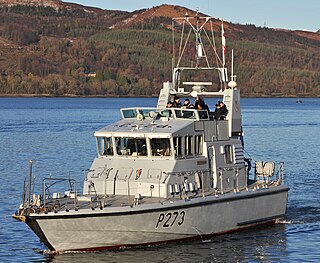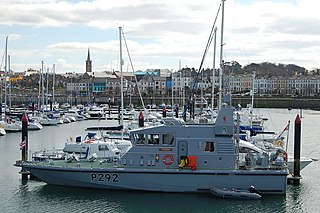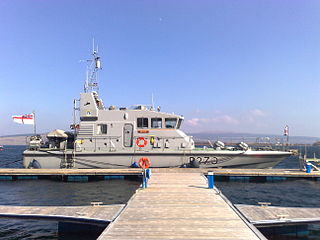
HMS Smiter is an Archer-class patrol and training vessel of the Royal Navy.

The University Royal Naval Units (URNU) are Royal Navy training establishments who recruit Officer Cadets from a university or a number of universities, usually concentrated in one geographical area. There are 17 URNUs in the UK, with each URNU having land-based facilities near the universities they recruit from, with the exception of URNU Virtual, whose drill nights are conducted virtually.

The Gibraltar Squadron is a unit of the British Royal Navy. It is the only seagoing Royal Naval unit based in Gibraltar, attached to British Forces Gibraltar. It currently includes two Cutlass-class fast patrol boats with a maximum speed of up to 41-knots. The first new vessel of this class, HMS Cutlass, arrived in Gibraltar in November 2021, followed by the second vessel, HMS Dagger, in March 2022. The squadron also uses three Pacific 24 rigid-hulled inflatable boats and deploys one diving support boat. The 2021 defence white paper indicated that henceforth, one River-class offshore patrol vessel, HMS Trent, would also be permanently based in Gibraltar for operations in the Mediterranean and in the Gulf of Guinea. As of 2023, 28 personnel were assigned to the squadron, along with additional personnel assigned to HMS Trent.

The Royal Naval Auxiliary Service (RNXS) was a uniformed, unarmed, civilian volunteer service, administered and trained by the Royal Navy to operate in the ports and anchorages of the United Kingdom in an emergency. Although the abbreviated title would logically have been RNAS this abbreviation had long been taken by the various Royal Naval Air Stations, so RNXS it was. It maintained training units, and vessels at most major ports in the UK. and was formed in 1963 from the amalgamation of the Royal Naval Mine-watching Service (RNMWS) and Admiralty Ferry Crew Association in response to the perceived nuclear threat to British ports. The service was disbanded on 31 March 1994 due to Ministry of Defence (MOD) cuts. Most vessels from its fleet were transferred to the Royal Navy or sold, with the exception of XSV Loyal Volunteer, which was struck by a ro-ro ferry while berthed in Ipswich Harbour and was later scrapped.

HMS Tracker is an Archer-class (P2000) patrol and training vessel of the British Royal Navy. Along with the batch 2 Archer class, HMS Raider, Tracker is part of the Faslane Patrol Boat Squadron based at HMNB Clyde.

HMS Archer is the lead ship of the Archer class. As the lead ship she was one of several of her class to be completed in 1985 by Watercraft Marine, the original shipbuilders — most of the remaining vessels were completed or built by Vosper Thornycroft. In 2015, she was one of the first of her class to receive an upgrade.

HMS Ranger is an Archer-class patrol and training vessel of the British Royal Navy, based in HMNB Portsmouth. She is affiliated to Sussex and Brighton Universities' University Royal Naval Unit, which has its offices at the University of Sussex, Brighton. Her badge is a ship's wheel superimposed on seven blue roundels, representing the seven seas.

HMS Pursuer is an Archer-class P2000 patrol and training vessel of the Royal Navy.

HMS Raider is an Archer-class patrol and training vessel of the British Royal Navy. Along with HMS Tracker, Raider is part of the Faslane Patrol Boat Squadron based at HMNB Clyde.

HMS Example is an Archer-class patrol and training vessel of the Royal Navy, based at HMS Calliope in Gateshead, England. Example was originally built for the Royal Naval Auxiliary Service, and was transferred to the Royal Navy when the RNXS disbanded in 1994. On transfer, she retained her name, and became the first ship in the Royal Navy to bear that name.
HMS Yaxham was one of 93 ships of the Ham class of inshore minesweepers.
HMS Exploit is an Archer-class patrol vessel of the British Royal Navy, built in Woolston by Vosper Thornycroft and commissioned in 1988. She is assigned to the Royal Navy Coastal Forces Squadron, carrying out a range of activities both in the U.K. and overseas.

The Archer class is a class of patrol and training vessel in service with the United Kingdom's Royal Navy, commonly referred to as a "fast training boat". Most are assigned to Coastal Forces Squadron. HMS Tracker and HMS Raider are armed and provide maritime force protection to high value shipping in the Firth of Clyde and are most commonly employed as escorts for submarines transiting to Faslane. Pursuer and Dasher were also armed during their deployment on maritime force protection duties with the Gibraltar Squadron from 2020-2022.

HMS Dasher is an Archer-class P2000 patrol and training vessel of the British Royal Navy. Dasher was built at Vosper Thorneycroft and commissioned in 1988.

HMS Express is an Archer-class P2000-type patrol and training vessel of the Royal Navy.

HMS Trumpeter is an Archer-class patrol vessel P2000-type patrol and training vessel of the British Royal Navy. Trumpeter is assigned to Cambridge University Royal Naval Unit, having previously been the training ship of the Bristol University Royal Naval Unit.

HMS Charger is an Archer-class patrol vessel built by Watercraft Limited, Shoreham-by-Sea and fitted out at Vosper Thornycroft. She is just over 20 metres long and 5.8 metres wide and powered by two Rolls-Royce turbo engines. The ship is based at HMS Eaglet, the Royal Naval Headquarters in Liverpool and was commissioned in 1988. She has five full-time RN crew, and sails with an RNR training officer and a maximum complement of 12 students. She is attached to the Liverpool University Royal Naval Unit.

HMS Puncher is an Archer-class patrol vessel of the Royal Navy. She is permanently based at HMNB Portsmouth and forms part of the First Patrol Boat Squadron (1PBS). Puncher is primarily tasked with training the officer cadets and midshipmen of the University of London's University Royal Naval Unit. She also provides a training platform for young officers undertaking training during the Royal Navy's initial warfare officers' course, and has also been used in the coastal protection role, most notably during Operation Olympic, the security operation surrounding the London 2012 Olympic Games.

HMS Biter is an Archer-class P2000-type patrol and training vessel of the British Royal Navy. She is assigned to Manchester & Salford Universities Royal Naval Unit, a Royal Naval Reserve unit based in Manchester. The ship is based at HMS Eaglet, the Royal Naval Headquarters in Liverpool. As part of her sea training programme, she often makes visits to local ports for ceremonial visits or occasions.
In 1989 the Royal Navy was under the direction of the Navy Department in the UK Ministry of Defence. It had two main commands, CINCFLEET and Naval Home Command.


















